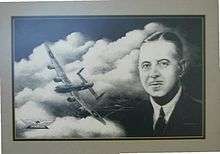Roy Chadwick
| Roy Chadwick | |
|---|---|
 | |
| Born |
30 April 1893 Farnworth, Widnes, Lancashire, England |
| Died |
23 August 1947 (aged 54) Woodford, Greater Manchester |
| Nationality | English |
| Education | UMIST |
|
Engineering career | |
| Institutions | Avro |
| Projects |
Avro Lancaster Avro Vulcan (designer) Avro Manchester |
| Significant advance | Aircraft |
| Awards | CBE |
Roy Chadwick, CBE, FRSA, FRAeS (30 April 1893 – 23 August 1947) was an aircraft design engineer for the Avro Company. Born at Marsh Hall Farm, Farnworth, the son of the mechanical engineer Charles Chadwick, he was the chief designer for Avro and was responsible for practically all of their aeroplane designs. He is famous in particular for designing the Avro Lancaster bomber, its follow-up Avro Lincoln and preliminary designs of the Avro Vulcan V bomber. He also converted the Lincoln into the much-used Shackleton. His Avro Yorks carried one third of the entire British tonnage during the Berlin Airlift.
Early life
Chadwick attended St Clements Church School in Urmston, then studied at night school from 1907 to 1911 at the Manchester Municipal College of Technology whilst working as a draughtsman at British Westinghouse in Trafford Park.
Avro years
At age 18 in September 1911, he began work as Alliott Verdon-Roe's (later Sir Alliott) personal assistant and the firm's draughtsman at A.V. Roe and Company based at Brownsfield Mill, Manchester. Under the direction of A.V. Roe, Chadwick drafted the Avro D, a two-seater tractor biplane, the Avro E, which was converted to a floatplane, and in 1912, the Avro F, the world's first monoplane and cabin machine. He then worked on the draughtsmanship for the Avro 500, 501 and 503, which led to Avro's World War I light bomber and trainer, the Avro 504. In 1915 at age 22, Chadwick designed the Avro Pike, a twin-engined pusher biplane bomber. That year, when starting to design entire aircraft, he was based at Hamble, near Southampton. In 1918 he designed the Avro Baby and in 1920, the Avro Aldershot, the world's largest single-engined bomber and variants of the Aldershot, the Avro Ava and the Avro Andover. In 1925 he designed an all-metal plane, the single-seater fighter Avro Avenger and in 1926, the Avro Avian. In 1928, he moved back to the Avro factory in Woodford, Greater Manchester, used today by BAE Systems. That year, he designed an eight-passenger high wing plane, the Avro 10 and a 4-passenger version, the Avro 4. In 1929, he designed the RAF trainer, the Avro Tutor, a smaller version, the Avro Cadet and an enclosed version, the Avro Commodore. This was followed by the Avro Anson, used in World War II for training crews and as transport aircraft.
In the late 1930s work began on a long-range bomber, the Avro Manchester, followed by the Avro Lancaster of which 7,300 were built. In 1939, production of Avro aircraft was moved to a new factory at Greengate in south Chadderton, today owned by BAE Systems. In 1941, he designed a long-range transport, the Avro York and larger variants of the Lancaster, the Avro Lincoln and the Avro Lancastrian.

After the war, he designed Britain's first pressurised airliner, the Avro Tudor, based around the Lancaster-derivative Avro Lincoln, though few were built and also the Avro Shackleton in 1946. His final involvement with Avro was overseeing the initial designs of the Vulcan from 1946. He died on 23 August 1947 in a crash during the takeoff of the prototype Avro Tudor 2 G-AGSU from Woodford Aerodrome, in the vicinity of Shirfold Farm. The accident was due to an error in an overnight servicing in which the aileron cables were inadvertently crossed.
Personal life
Chadwick was appointed a Commander of the Order of the British Empire in the 1943 Birthday Honours.[1] He is commemorated by a blue plaque on the surviving office building of the Avro factory at Greengate.[2]
His bust is displayed at the RAF Club in London, among other notable designers.
See also
- Stuart Davies (engineer), also responsible for the Avro Lancaster (an updated Avro Manchester)
- Claude Lipscombe (CPT Lipscombe), designer of the Short Stirling
- George Volkert, responsible for the Handley Page Halifax
References
- ↑ The London Gazette: no. 36033. p. 2432. 28 May 1943.
- ↑ Manchester Genealogist Vol 43 No.3 2007 Pages 278-9
External links
- Biography and Avro history.
- Biography from a list of Manchester celebrities
- A picture of the Tudor 2 G-AGSU in which Chadwick was killed